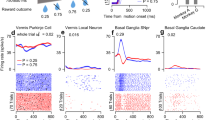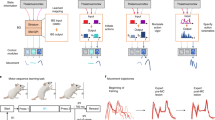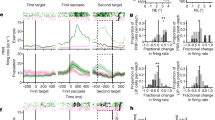Abstract
The manner in which the nervous system allocates limited motor resources when confronted with conflicting behavioural demands is a crucial issue in understanding how sensory information is transformed into adaptive motor responses. Understanding this selection process is of particular concern in current models of functions of the basal ganglia1. Here we report that the basal ganglia use simultaneous enhancing and suppressing processes synergistically to modulate sensory activity in the superior colliculi, which are bilaterally paired midbrain structures involved in the control of visual orientation behaviours2. These complementary processes presumably ensure accurate gaze shifts mediated by the superior colliculi despite the presence of potential distractors.
This is a preview of subscription content, access via your institution
Access options
Subscribe to this journal
Receive 51 print issues and online access
$199.00 per year
only $3.90 per issue
Buy this article
- Purchase on Springer Link
- Instant access to full article PDF
Prices may be subject to local taxes which are calculated during checkout




Similar content being viewed by others
References
Redgrave, P., Prescott, T. J. & Gurney, K. The basal ganglia: a vertebrate solution to the selection problem. Neuroscience 89, 1009–1023 (1999)
Stein, B. E. & Meredith, M. A. The Merging of the Senses (MIT Press, Cambridge, Massachusetts, 1993)
Lee, C., Rohrer, W. H. & Sparks, D. L. Population coding of saccadic eye movements by neurons in the superior colliculus. Nature 332, 357–360 (1988)
Munoz, D. P. & Guitton, D. Tectospinal neurons in the cat have discharges coding gaze position error. Brain Res. 341, 184–188 (1985)
Chevalier, G., Vacher, S. & Deniau, J. M. Inhibitory nigral influence on tectospinal neurons, a possible implication of basal ganglia in orienting behaviour. Exp. Brain Res. 53, 320–326 (1984)
Chevalier, G., Vacher, S., Deniau, J. M. & Desban, M. Disinhibition as a basic process in the expression of striatal function. I. The striato-nigral influence on tecto-spinal/tecto-diencephalic neurons. Brain Res. 334, 215–226 (1985)
Hikosaka, O. & Wurtz, R. H. Visual and oculomotor function of monkey substantia nigra pars reticulata. IV. Relation of substantia nigra to superior colliculus. J. Neurophysiol. 49, 1285–1301 (1983)
Joseph, J. P. & Boussaoud, D. Role of the cat substantia nigra pars reticulata in eye and head movements. 1. Neural activity. Exp. Brain Res. 57, 286–296 (1985)
Beckstead, R. M. A comparison of the intranigral disribution of nigrotectal neurons labelled with horseradish peroxidase in the monkey, cat and rat. J. Neurosci. 1, 121–125 (1981)
Harting, J. K., Huerta, M. F., Hashikawa, R., Weber, J. T. & Van Lieshout, D. P. Neuroanatomical studies of the nigrotectal projection in the cat. J. Comp. Neurol. 278, 615–631 (1988)
Chevalier, G., Thierry, A. M., Shibazaki, T. & Feger, J. Evidence for a GABAergic inhibitory nigrotectal pathway in the rat. Neurosci. Lett. 21, 67–70 (1981)
Karabelas, A. B. & Moschovakis, A. K. Nigral inhibitory termination of efferent neurons of the superior colliculus: an intracellar horseradish peroxidase study in the cat. J. Comp. Neurol. 239, 309–329 (1985)
May, P. J. & Hall, W. C. Relationships between the nigrotectal pathway and the cells of origin of the predorsal bundle. J. Comp. Neurol. 226, 357–376 (1984)
Chevalier, G. & Deniau, J. M. Disinhibition as a basic process in the expression of striatal functions. Trends Neurosci. 13, 277–280 (1990)
Wallace, S. F., Rosenquist, A. C. & Sprague, J. M. Ibotenic acid lesions of the lateral substantia nigra restore visual orientation behaviour in the hemianopic cat. J. Comp. Neurol. 296, 222–252 (1990)
Ryan, L. J. & Clark, K. B. The role of the subthalamic nucleus in the response of globus pallidus neurons to stimulation of the prelimbic and agranular frontal cortices in rats. Exp. Brain Res. 86, 641–651 (1991)
Kha, H. T. et al. Projections from the substantia nigra pars reticulata to the motor thalamus of the rat: single axon reconstructions and immunohistochemical study. J. Comp. Neurol. 440, 20–30 (2001)
Mize, R. R., Luo, Q., Butler, G., Jeon, C. J. & Nabors, B. The calcium-binding proteins parvalbumin and calbindin-D 28K form complementary patterns in the cat superior colliculus. J. Comp. Neurol. 320, 243–256 (1992)
Kalesnykas, R. P. & Sparks, D. L. The interaction of visual and electrical activity of neurons in the monkey superior colliculus: Site and train characteristics affect saccade latency, amplitude and direction. Soc. Neurosci. Abstr. 25, 1920 (1999)
Wang, S. & Redgrave, P. Microinjections of muscimol into lateral superior colliculus disrupt orienting and oral movements in the formalin model of pain. Neuroscience 81, 967–988 (1997)
Infante, C. & Leiva, J. Simultaneous unitary neuronal activity in both superior colliculi and its relation to eye movements in the cat. Brain Res. 381, 390–392 (1986)
Behan, M. An EM-autoradiographic and EM-HRP study of the commissural projection of the superior colliculus in the cat. J. Comp. Neurol. 234, 105–116 (1985)
Mink, J. W. The basal ganglia: focused selection and inhibition of competing motor programs. Prog. Neurobiol. 50, 381–425 (1996)
Handel, A. & Glimcher, P. W. Contextual modulation of substantia nigra pars reticulata neurons. J. Neurophysiol. 83, 3042–3048 (2000)
Sato, M. & Hikosaka, O. Role of primate substantia nigra pars reticulata in reward-oriented saccadic eye movement. J. Neurosci. 22, 2363–2373 (2002)
Alexander, G. E. & Crutcher, M. D. Functional architecture of basal ganglia circuits: neural substrates of parallel processing. Trends Neurosci. 13, 266–271 (1990)
Kita, H. & Kitai, S. T. Efferent projections of the subthalamic nucleus in the rat: light and electron microscopic analysis with the PHA-L method. J. Comp. Neurol. 260, 435–452 (1987)
Sprague, J. M. Interactions of cortex and superior colliculus in mediation of visually guided behavior in the cat. Science 153, 1544–1547 (1966)
Wallace, S. F., Rosenquist, A. C. & Sprague, J. M. Recovery from cortical blindness mediated by destruction of nontectotectal fibres in the commissure of the superior colliculus in the cat. J. Comp. Neurol. 284, 429–450 (1989)
Karnath, H. O. New insights into the functions of the superior temporal cortex. Nature Rev. Neurosci. 2, 568–576 (2001)
Acknowledgements
We thank R. Coghill, P. Redgrave and T. Stanford for their critical comments on earlier versions of the manuscript, and N. London for editorial assistance. This work was supported by a grant from the National Institutes of Health to J.G.M. H.J. was partly supported by a grant from the National Institutes of Health to B.E.S.
Author information
Authors and Affiliations
Corresponding author
Ethics declarations
Competing interests
The authors declare that they have no competing financial interests.
Rights and permissions
About this article
Cite this article
Jiang, H., Stein, B. & McHaffie, J. Opposing basal ganglia processes shape midbrain visuomotor activity bilaterally. Nature 423, 982–986 (2003). https://doi.org/10.1038/nature01698
Received:
Accepted:
Issue Date:
DOI: https://doi.org/10.1038/nature01698
This article is cited by
-
Neural mechanisms for the localization of unexpected external motion
Nature Communications (2023)
-
Striatal indirect pathway mediates exploration via collicular competition
Nature (2021)
-
Transforming absolute value to categorical choice in primate superior colliculus during value-based decision making
Nature Communications (2021)
-
Evidence for a task-dependent switch in subthalamo-nigral basal ganglia signaling
Nature Communications (2017)
-
The effects of unilateral versus bilateral subthalamic nucleus deep brain stimulation on prosaccades and antisaccades in Parkinson’s disease
Experimental Brain Research (2017)
Comments
By submitting a comment you agree to abide by our Terms and Community Guidelines. If you find something abusive or that does not comply with our terms or guidelines please flag it as inappropriate.



